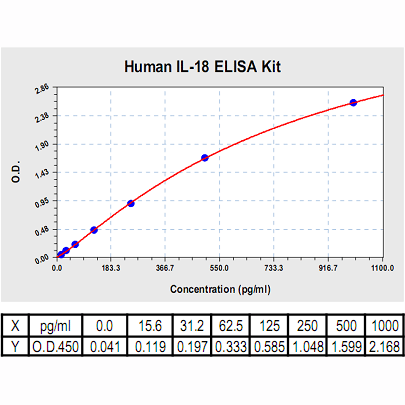IL-18 ELISA Kit, Human |
 |
BACKGROUND IL-18 is a member of the interleukin (IL)-1 family, with profound effects on T-cell activation. IL-18 has potent immunomodulatory effects. It is the only cytokine with a unique capacity to induce T helper 1 or T helper 2 polarization, depending on the immunologic context. Formerly called interferon (IFN) gamma inducing factor (IGIF), IL-18 is the new name of a novel cytokine that plays an important role in the T-cell-helper type 1 (Th1) response, primarily by its ability to induce IFNgamma production in T cells and natural killer (NK) cells.1 Mice deficient in IL-18 have suppressed IFNgamma production despite the presence of IL-12. IL-18 is related to the IL-1 family in terms of structure, receptor family, and function. In terms of structure, IL-18 and IL-1beta share primary amino acid sequences of the so-called “signature sequence” motif and are similarly folded as all-beta pleated sheet molecules. Also similar to IL-1beta, IL-18 is synthesized as a biologically inactive precursor molecule lacking a signal peptide which requires cleavage into an active, mature molecule by the intracellular cysteine protease called IL-1beta-converting enzyme (ICE, also called caspase-1). The activity of mature IL-18 is closely related to that of IL-1. IL-18 induces gene expression and synthesis of tumor necrosis factor (TNF), IL-1, Fas ligand, and several chemokines. The activity of IL-18 is via an IL-18 receptor (IL-18R) complex. This IL-18R complex is made up of a binding chain termed IL-18Ralpha, a member of the IL-1 receptor family previously identified as the IL-1 receptor-related protein (IL-1Rrp), and a signaling chain, also a member of the IL-1R family. The IL-18R complex recruits the IL-1R-activating kinase (IRAK) and TNFR-associated factor-6 (TRAF-6) which phosphorylates nuclear factor kappaB (NFkappaB)-inducing kinase (NIK) with subsequent activation of NFkappaB.2 Similar to IL-1, IL-18 participates in both innate and acquired immunity.
There are several indications that IL-18 plays a pathogenetically important role in chronic inflammatory conditions of epithelial organs (such as skin, gut, kidney) and importantly also in responses against self. Several autoimmune diseases are thought to be mediated, in part, by IL-18. Many are those with associated elevated interferon-gamma (IFN-gamma) levels. Animal studies also support the concept that IL-18 is a key player in models of lupus erythematosus, atherosclerosis, graft versus host disease and hepatitis. Increased levels of IL-18 can be detected in biological fluids and organs of individuals affected by several autoimmune pathologies, as well as in autoimmune animal models. Unexpectedly, IL-18 plays a role in appetite control and the development of obesity. Moreover, The metabolic syndrome is thought to be associated with a chronic low-grade inflammation, and a growing body of evidence suggests that IL-18 might be closely related to the metabolic syndrome and its consequences.3 The IL-18-binding protein, a naturally occurring, specific inhibitor of IL-18, neutralizes IL-18 activities and has been shown to be safe in patients.4
There are several indications that IL-18 plays a pathogenetically important role in chronic inflammatory conditions of epithelial organs (such as skin, gut, kidney) and importantly also in responses against self. Several autoimmune diseases are thought to be mediated, in part, by IL-18. Many are those with associated elevated interferon-gamma (IFN-gamma) levels. Animal studies also support the concept that IL-18 is a key player in models of lupus erythematosus, atherosclerosis, graft versus host disease and hepatitis. Increased levels of IL-18 can be detected in biological fluids and organs of individuals affected by several autoimmune pathologies, as well as in autoimmune animal models. Unexpectedly, IL-18 plays a role in appetite control and the development of obesity. Moreover, The metabolic syndrome is thought to be associated with a chronic low-grade inflammation, and a growing body of evidence suggests that IL-18 might be closely related to the metabolic syndrome and its consequences.3 The IL-18-binding protein, a naturally occurring, specific inhibitor of IL-18, neutralizes IL-18 activities and has been shown to be safe in patients.4
REFERENCES
1. Reddy, P.: Curr. Opin. Hematol. 11:405-10, 2004
2. Dinarello, C.A.: Semin. Nephrol. 27:98-114, 2007
3. Trøseid, M. et al: Cardiovasc. Diabetol. 9:11, 2010
4. Dinarello, C.A. et al: J. Leukoc. Biol. 63:658-64, 1998
2. Dinarello, C.A.: Semin. Nephrol. 27:98-114, 2007
3. Trøseid, M. et al: Cardiovasc. Diabetol. 9:11, 2010
4. Dinarello, C.A. et al: J. Leukoc. Biol. 63:658-64, 1998
Products are for research use only. They are not intended for human, animal, or diagnostic applications.
Параметры
Cat.No.: | CL0864 |
Target Protein Species: | Human |
Range: | 15.6 pg/ml – 1000 pg/ml |
Specificity: | No detectable cross-reactivity with other cytokines |
Storage: | Store at 4°C. Use within 6 months. |
ELISA Kits are based on standard sandwich enzyme-linked immunosorbent assay technology. Freshly prepared standards, samples, and solutions are recommended for best results.
Документы
Информация представлена исключительно в ознакомительных целях и ни при каких условиях не является публичной офертой








